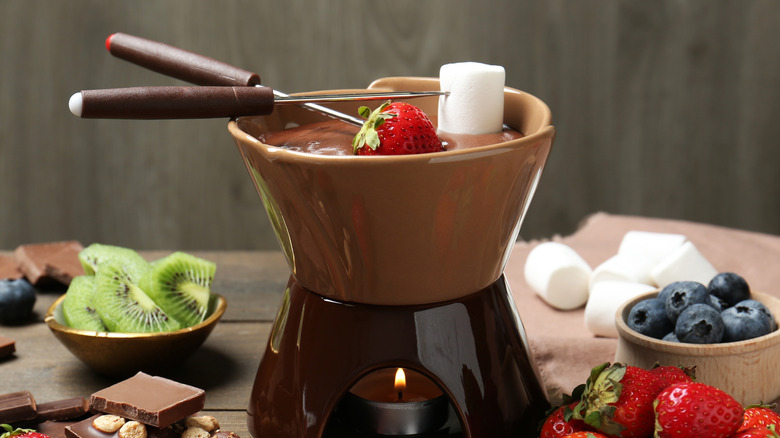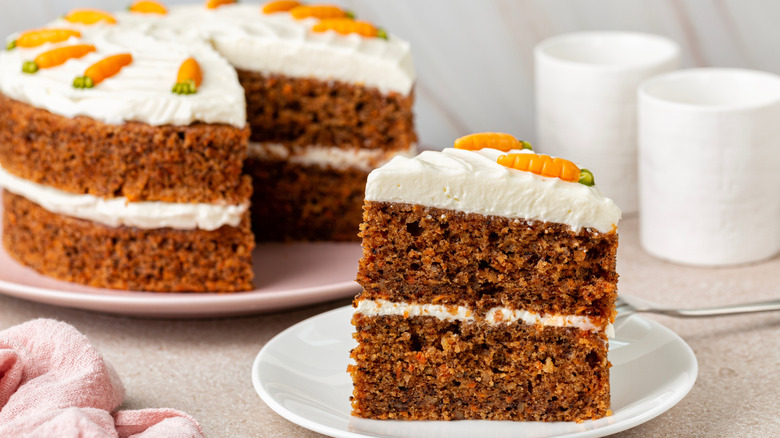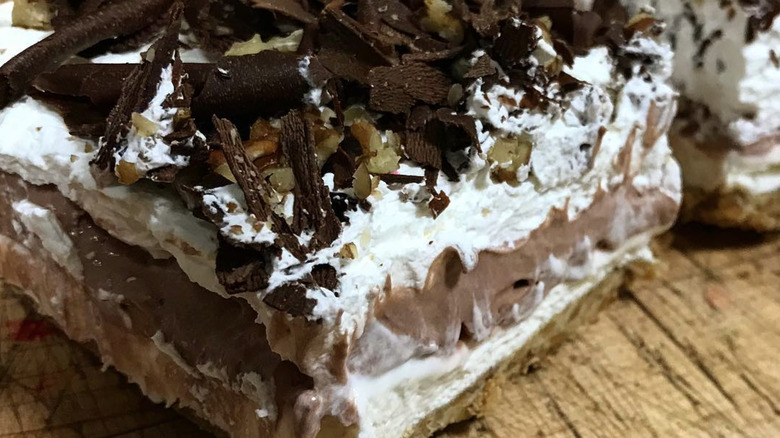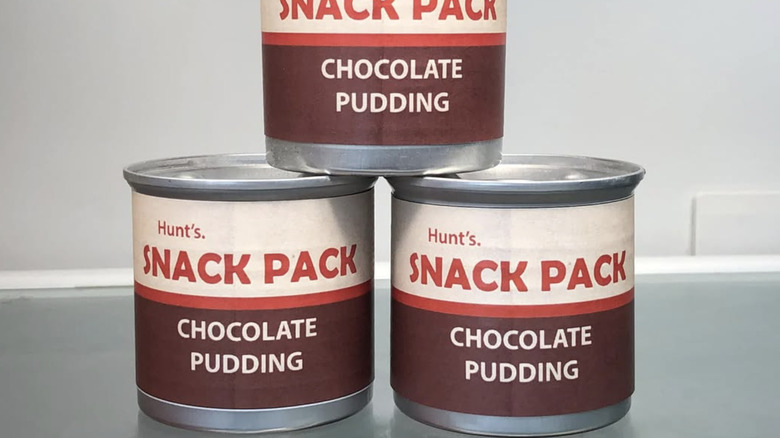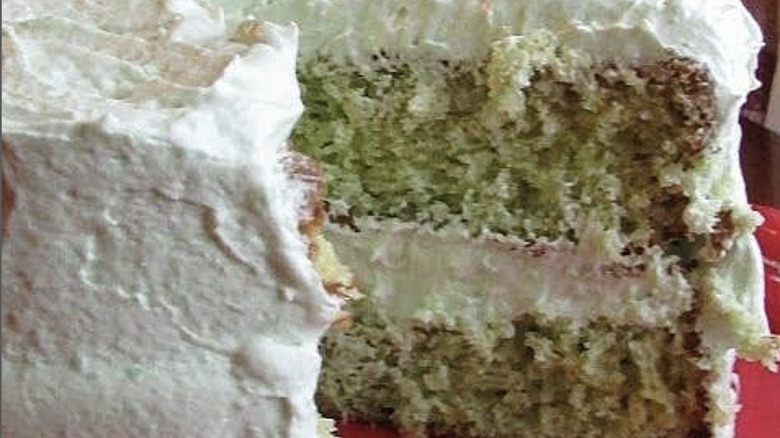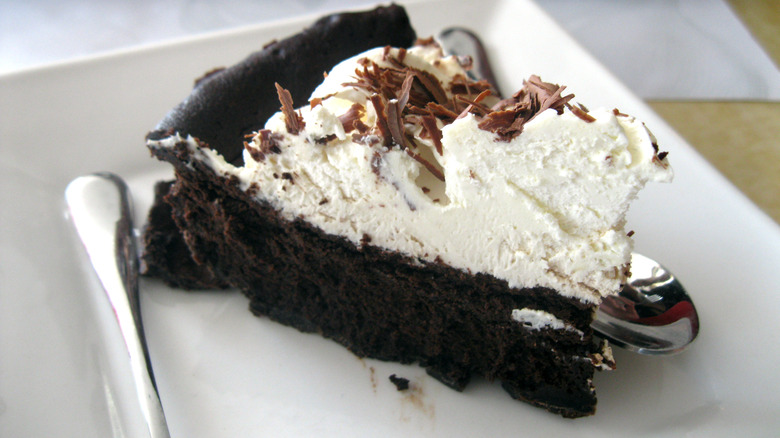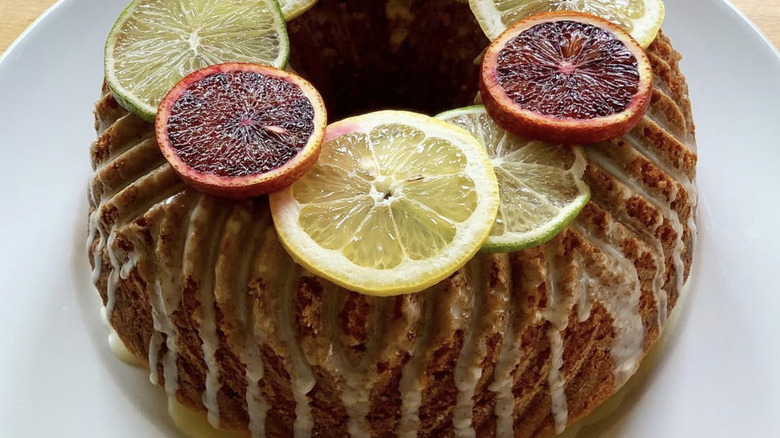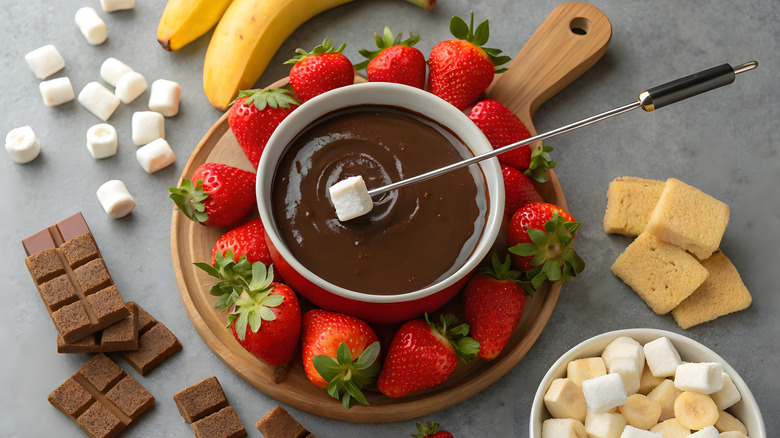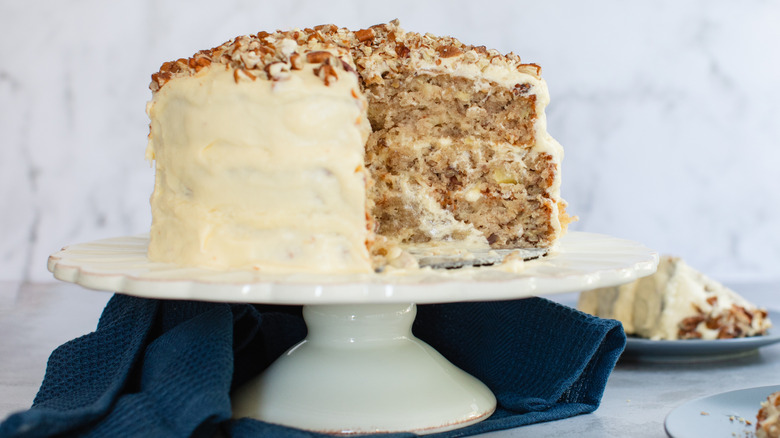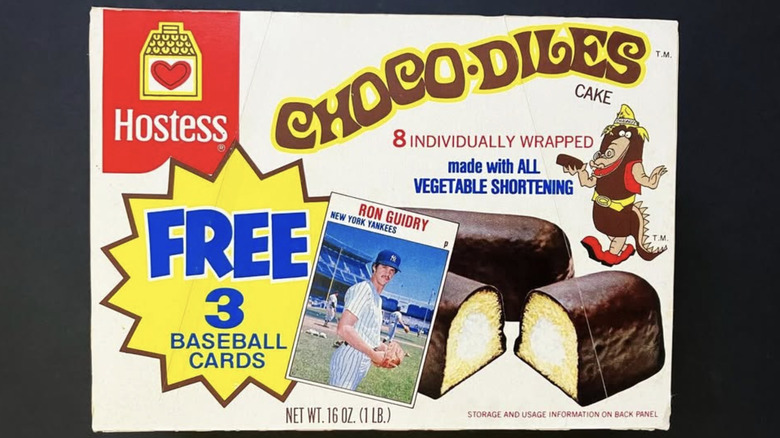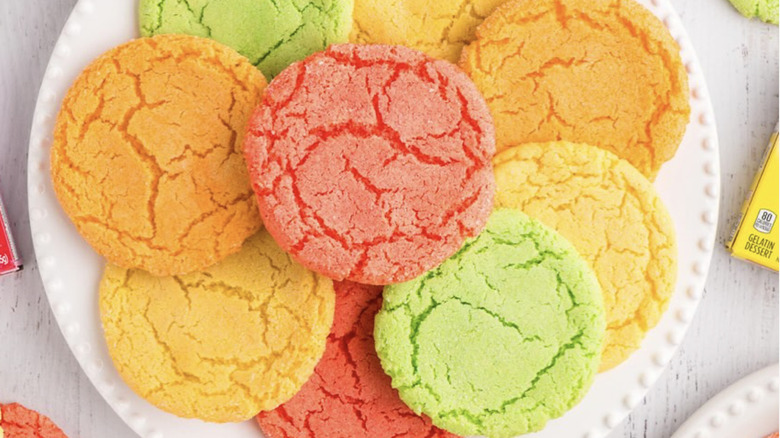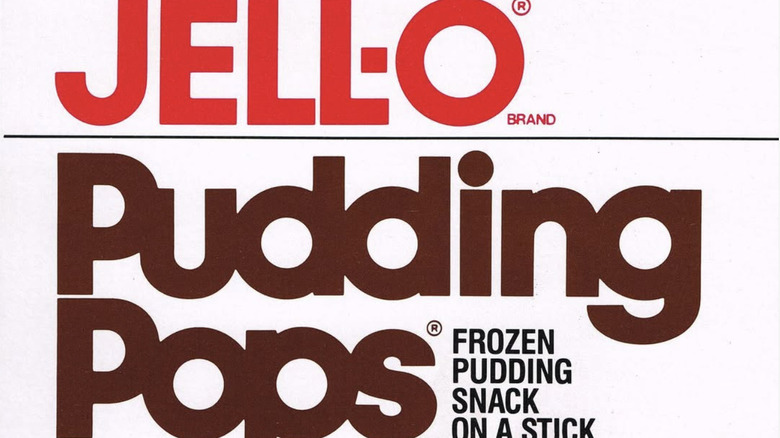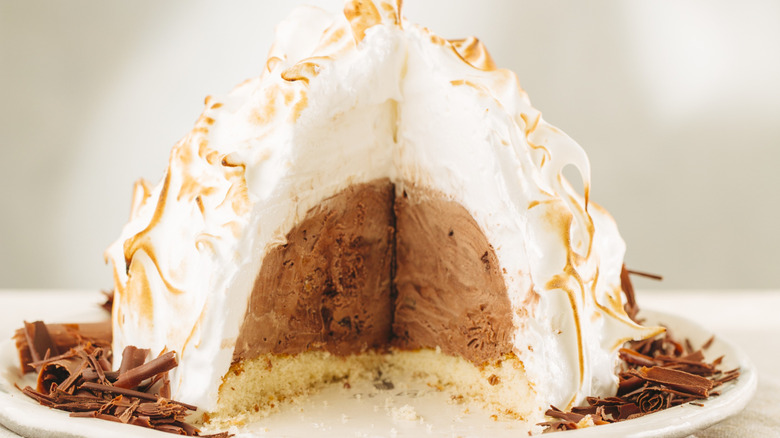Vintage Desserts People Loved In The 1970s
Depending on one's age, one of only a few notions pops into their head at the mention of food in the 1970s. Older people who were adults during the decade of earth tones, bell bottoms, and Nixon might remember raucous dinner parties with friends or community potlucks, downing elaborate cocktails to chase casseroles or various examples of weird '70s cookbook food. Those who were children during the decade may remember not very good school lunches, packaged snacks, or homemade desserts. In fact, everyone around in the 1970s may remember the desserts the best. By and large, meal-finishers or between-meal snacks in the 1970s were all about packing as much flavor, sugar, and ingredients into a dessert as possible, making for some definitive sweets.
Food can be as faddish as fashion or technology, and the 1970s offered up plenty of examples. Here are some well-remembered and long-forgotten desserts that, whether they survived to the present day or not, remain closely associated with the time in which they were most commonly eaten and loved: the '70s.
Carrot cake
Carrot-based desserts date back to Medieval times, and carrot cake was a well-known entity before the 1970s. It remains a fixture of home bakers, bakeries, and restaurants well into the 21st century — but the carrot cake enjoyed a sustained burst of prominence in the early 1970s. It all had to do with the decade's closely related dieting trends and health food movement. Americans made an effort to eat healthier, and that meant incorporating more vegetables into their diets. With many eschewing processed foods and traditional desserts, but still wanting a sweet treat on occasion, the carrot cake emerged as a compromise. While it's a standard spice cake made with plenty of flour and sugar, the shredded carrots in the batter were perceived as making the densely caloric dessert appear healthy.
There was also the matter of the frosting. Carrot cake, gently flavored with potent spices, pairs well with a tangy and sweet cream cheese frosting. That also seemed healthier than the usual cake frostings that came in a can or were made from little more than sugar and butter, so it helped perpetuate the notion that carrot cake was a healthy dessert. That frosting wasn't any better for a dieter than standard frostings, but it sure did taste good to the people of the 1970s.
Robert Redford cake
Over the past few decades, this dessert has persisted with slight variations in its ingredients as well as in what people call the chocolatey confection. References to the "Holy Cow Cake" or the "Better Than Sex Cake" appear in cookbooks and on food blogs, but it was originally known by a name having something to do with Robert Redford, one of the most bankable movie stars and lusted after male sex symbols of the 1970s. His appearances in films like "The Way We Were" and "The Sting" were so well-received that he inspired the creation of the "Robert Redford Cake," or "Better Than Robert Redford," or "The Next Best Thing to Robert Redford."
The actor actually had a loose but direct association with the dessert that usually bore his name. Celebrity baker Maida Heatter prepared a cake in a Manhattan restaurant, the story goes, and one night Redford came in and enjoyed it so much that Heatter named it in tribute. That was a chocolate cake made with honey instead of sugar, and that became the basis for a messy dessert with multiple sources of sweetness and chocolate.
While the chocolate cake at the foundation of the Robert Redford cake wasn't always sweetened with honey in its 1970s heyday, it was customarily topped with whipped cream or Cool Whip as well as chopped up candy bars and another topping, like caramel or chocolate sauce. Some intrepid bakers also incorporated a pecan-based pie crust.
Snack Pack
Pudding is thoroughly entrenched in the American dessert pantheon as a quick, easy, convenience food. Whether purchased in individually-portioned plastic cups, which can sit in a fridge for long periods of time and used as a go-to modest dessert or lunch box sweet or made by adding milk to a box of powdered mix and allowed to chill for an hour, pudding doesn't take long to enjoy. Previously a solely made-from-scratch dessert, the first boxed pudding mixes hit stores in 1918. But the first time that pre-made, instantly eatable pudding was broached to the public was with the arrival of Hunt's Snack Pack in 1968. Within a few short years, the pudding would rank among the most popular desserts for 1970s children.
Promoted with a live horse mascot named Snack Pack, the shelf-stable and refrigeration-unnecessary pudding came in small metal cans with pop-off lids, and initially was served in flavors including butterscotch and chocolate fudge. Dense in flavor and texture, Hunt's Snack Pack made for a velvety, sweet, and creamy appearance. Hunt's switched out the metal for plastic cups in 1984 and while it didn't much change the recipe, that pudding no longer tasted the way it once did.
Watergate cake
With a name and construction that were a wry and satirical nod to the decade's biggest scandal, and a novelty in multiple ways, the Watergate cake is a quintessentially 1970s dessert. But before there was Watergate cake, there was Watergate salad. An old-school side dish that almost everyone has forgotten about, Watergate salad is a variant on fruit salads like ambrosia that had been commonplace since the late 19th century. The standard recipe for Watergate salad — originally known as pistachio salad or pistachio delight – would come to include pistachio pudding, pineapple, miniature marshmallows, whipped topping, chopped nuts, and Maraschino cherries.
By the 1970s, pistachio salad was rather mundane, but it would get a makeover and inspire a full-on dessert sometime around 1974. That year, President Nixon resigned over his involvement in the Watergate affair, in which he was linked to five burglars who broke into the Democratic National Committee offices in Washington, D.C.'s Watergate complex. Right around that time, home cooks had made the pistachio salad into a cake by adding a boxed cake mix, vegetable oil, club soda, and coconut flakes, and often deleting the pineapple and marshmallows. Green-colored icing to match the green-colored cake went on top, or sometimes pistachio pudding, which hid a layer of nuts. More playful cooks wouldn't try very hard to hide the nuts, alluding to how Nixon didn't ultimately do a very good job of covering up his crimes or association with shady figures.
Mississippi mud pie
The 1970s was a decade characterized somewhat by self-indulgence, and that's reflected in the rise of the Mississippi mud pie. While similar to variations like dirt cake and chocolate lasagna, this extremely decadent and chocolate-forward dish starts with a chocolate cookie crust and just goes from there. It tends to incorporate chocolate cake, ice cream, pudding, whipped cream, marshmallows, chocolate syrup, pecans, almonds, chocolate shavings, and chocolate liqueur.
The exact origin of the Mississippi mud pie is subject to debate. It likely developed out of Mississippi mud cake, a dessert served in the Deep South made up of chocolate fudge cake adorned with a marshmallow sauce and chocolate frosting. Other food historians say it was invented in Vicksburg, Mississippi, in the late 1920s, when a restaurant cook was inspired to make a chocolate dessert by the dark-brown mucky banks of the Mississippi River. Over time, the dessert's popularity spread out of the South and to the rest of the U.S., reaching critical mass in the 1970s. The chain The Chart House putting the pie on its menu in the 1970s is partially responsible, and it's remained a well-known dessert since.
Harvey Wallbanger cake
The Harvey Wallbanger was so frequently ordered in bars and prepared on in-home bars in the 1970s that the key ingredient was the most imported liqueur across the whole decade. The drink was likely invented by the marketing staff at McKesson Imports, the company that trafficked Galliano, an orange liqueur that's mixed with orange juice and vodka to make for a strong and citrus-heavy libation. As the drink was widely consumed at the many parties, dinner parties, and gatherings of the 1970s, so too was the dessert that the well-established cocktail inspired.
Featured in a 1972 cooking booklet included with a Sunbeam electric frypan that sold well into the 1970s, the Harvey Wallbanger cake took the flavors of the drink and exported them to a dessert. It was easy to make, too, combining ingredients home bar-keepers already had on hand for Harvey Wallbangers with some pantry staples. Bakers simply combined a box of cake mix — standard yellow or orange if they could find it — with instant vanilla pudding powder, oil, eggs, sugar, orange juice, vodka, and Galliano. The whole thing was topped with an orange glaze and, to make the cake highly presentable, sliced oranges and other citrus fruits or zest.
Chocolate fondue
One of the biggest and most all-encompassing fads of the late 1960s and most of the 1970s: the fondue party. Inspired by a faddish 1950s revival of the 18th century Swiss-French culinary tradition of dipping things like bread and meat pieces into a communal cauldron of hot and bubbling melted cheese, Americans embraced the very social dining phenomenon throughout the decade. Sales of fondue kits — which included little more than a small pot and bunch of skewers — skyrocketed in the 1970s, and fondue-themed chains like The Melting Pot filled their dining rooms nightly. It took off in the U.S. in large part because of the sudden availability of once exotic and now imported European cheeses, like Emmentaler, Appenzeller, and Gruyere.
But a meal can't be all cheese. As an extra treat to follow the main course, fondue lovers and fondue restaurants introduced a dessert that could be prepared on the same equipment they already had: chocolate fondue. A whole new round of decadent dipping would commence, with sweets like cookies, cake, and various fruits paring well with melted chocolate.
Hummingbird cake
The impact of a major geopolitical event of the 1960s, and its related economic fallout, directly led to one of the most widely consumed desserts of the 1970s. In 1962, Jamaica declared its independence from the United Kingdom when it was at a financial impasse. Its once robust sugar industry had dissolved after the elimination of the slave labor used to work its many plantations, leaving Jamaican officials to turn to tourism to bolster its coffers. A newly empowered Jamaica Tourist Board marketed the sun-drenched, beach-heavy Caribbean nation as a vacation spot with advertising campaigns distributed around the world. This coincided with the mass worldwide exporting of fruit from the Caribbean, marketed by companies with TV ads showing off the produce's origin points.
The Jamaica Tourist Board capitalized on the craze for tropical fruits, commissioning and placing in newspapers around the country a recipe for hummingbird cake, built around two widely available local ingredients – banana and pineapple. Newspaper editors in the U.S., mostly in the South, were made aware of that recipe, too, and popularized it Stateside, where it remained one of the most frequently baked cakes throughout the 1970s.
Named for the national bird of Jamaica, the hummingbird cake is a vanilla, nutmeg, and cinnamon-spiced sponge cake with bananas and pineapple finely blended into the mix. It's topped with a cream cheese frosting and chopped nuts.
Chocodiles
Good things can be made great with a simple tweak, such as taking a Twinkie and covering the cream-stuffed yellow sponge cake with a thin chocolate coating. That's a Chocodile, introduced in test markets by Hostess in 1977 before a series of nationwide rollouts later in the decade. Chocodiles were such a high-profile part of the Hostess family of products that, like Twinkie the Kid and King Ding Dong, the treat got its own mascot to appear in print advertisements and at live events: a silly reptilian creature named Chauncey Crocodile.
Chocodiles instantly caught on as an afterschool snack, lunch box dessert, or night-time treat, particularly with kids, and sold competitively with Hostess's Twinkies and cupcakes. But sales faltered over time, and by 1999, they were only sold on the West Coast.
After an online secondary market for old Chocodiles developed, Hostess revived the product in 2014, and would stock them in stores off and on over the past decade. The Chocodile name and imagery has since been retired in favor of the modern and sedate Fudge Covered Twinkies. Chocodiles can now technically be considered a discontinued Hostess snack we'll probably never eat again.
Jell-O Fruity Cookies
Sugar cookies are a fine enough cookie, but they're also a foundational treat, inviting and able to withstand all kinds of modifications and improvements. Those simple, largely flavorless cookies made up of mostly flour and just a little bit of sugar can be gussied up by most any home baker with even the slightest burst of creativity. In the 1970s, one of the most prevalent takes on the humble, colorless sugar cookie was the flavorful, brightly colored, and texturally interesting Jell-O Fruity Cookie.
Coming out of ovens in the 1960s but in a more widespread manner in the 1970s when a recipe was featured for in an ad for the most notable name brand in fruit-flavored gelatin, Jell-O Fruity Cookies added the unique aspects of Jell-O with those of baked goods. Like Jell-O, the cookies were brightly colored and strongly flavored with a candy-meets-fruit sensibility, while the properties of the gelatin made an otherwise crunchy and dry cookie quite soft and moist. It took little effort and some generally on-hand supplies to make Jell-O Fruity Cookies — just a box of any flavor of Jell-O and sugar cookie makings — which probably explains why so many households added them to their dessert rotation in the 1970s.
Pudding pops
No matter the flavor, pudding pops are pure whimsy on a stick. Before they were a dessert people loved to eat in the 1980s, pudding pops – homemade and store-bought — were a 1970s classic sweet treat. Earlier in the decade, the pudding pop was something parents or kids themselves had to make basically from scratch, preparing the instant pudding as directed on boxes of Jell-O manufactured stuff, with the addition of ingredients like evaporated milk and extra sugar. Upon freezing, they were a terrific and ultimately nostalgic summer treat, akin to a popsicle in its portability and how they formed around sticks, but as luscious and creamy as ice cream.
In 1974, food scientists at Jell-O's parent company General Foods began developing a recipe for the industrial production of pudding pops, and by 1978, began to test market varieties in its most popular boxed pudding mix flavors: chocolate, vanilla, butterscotch, and banana. Brand-named Pudding Pops were a major snack and dessert favorite available nationally when the early 1980s rolled around.
Baked Alaska
While it was invented a century earlier and is likely a derivative of the French meringue-covered layered cake and ice cream dessert known as the Omelette Norwegge, the Baked Alaska became both a kitschy classic and an undeniable showstopper in the 1970s. Quite the complicated dessert, and thus one hard to get quite right, the Baked Alaska is multiple treats in one: a base of cake covered by a carefully crafted ice cream in a dome shape. Flavors of either element may vary, but what truly makes the dish a Baked Alaska is when the whole thing gets draped in meringue, which is then gently and lightly toasted.
Believed to have originated in the late 1860s to celebrate the 1867 acquisition by the United States of what would one day become the state of Alaska, Baked Alaska enjoyed a major revival in the 1970s as an impressive dessert designed to feed a large group of people. Once the '80s rolled around, the once novel and always complex Baked Alaska had fallen out of favor.
